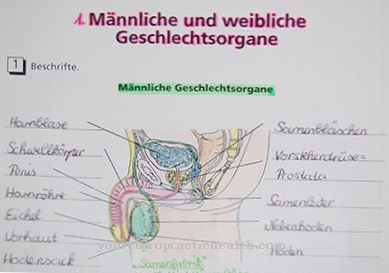Childhood illness is one of the more harmless viral infections Three-day fever. Small children between six months and three years of age are usually infected with this disease from other children. Typical signs are a high fever, skin rash and possibly febrile seizures. An examination by the pediatrician is advisable.
What is three day fever?

© Sasenki - stock.adobe.com
Three-day fever (Exanthema subitum, Roseola infantum or sixth illness) is an acute, but mostly harmless, viral infection. The childhood disease three-day fever occurs preferentially in infants from the 6th month of life to the toddler age of 3 years.
The main season for three-day fever is spring and autumn. Children with three-day fever suffer from a sudden high rise in fever. For the most part, there are no other symptoms of the disease. The fever lasts for 3 to 5 days and then drops suddenly.
Then the rash typical of three-day fever develops. Often only then can a reliable diagnosis be made. After the disease there is lifelong immune protection against three-day fever.
causes
Three-day fever are caused by two different human herpes pathogens. Mainly the herpes virus 6 (HHV-6) and only rarely the herpes virus 7 (HHV-7) triggers the three-day fever. The virus infection three-day fever is spread by a so-called droplet infection.
The viruses are transmitted when you cough, sneeze, or speak. But the use of the same drinking vessel or cutlery can cause infection. After a three-day fever, the viruses remain in the body for life and are sometimes excreted in the saliva. So healthy people can then infect children.
The incubation period, the time from infection to the onset of the disease, is around 3 to 15 days. Three-day fever is highly contagious. As a result, almost all children of kindergarten age have already lived through three-day fever.
You can find your medication here
➔ Medicines for fever and chillsSymptoms, ailments & signs
In three-day fever, temperatures typically rise suddenly from 39 to 41 degrees Celsius. The rise in temperature occurs for no apparent cause and persists for three to five days. After the fever has subsided, other symptoms will appear.
A mottled, bright red rash appears all over their bodies in a quarter of those affected. It is particularly noticeable in the torso, chest and neck area. The small spots, which usually appear in groups, can combine to form large spots and eventually spread to the arms and legs.
The rash often goes away on its own after hours or a day or two. Subsequent to or accompanying the skin changes, a number of other symptoms and complaints can occur. Many sufferers complain of eyelid swelling or visual problems. You may experience coughing and shortness of breath, as well as swollen cervical lymph nodes.
Intestinal inflammation also occurs in many cases. In a third of the cases, the disease causes a severe febrile seizure, in which the affected person becomes unconscious and cramps arms and legs. The cramp subsides after a few minutes. In infants, three-day fever manifests itself, among other things, through a bulging fontanel.
course
The disease three-day fever begins largely violently. A rapid, high rise in temperature, often up to 41 ° body temperature, is characteristic of three-day fever. The fever lasts for about 3 to 5 days. After surviving three days of fever, the temperature suddenly drops. The rash typical of three-day fever develops. This small-spotted, rubella-like rash (exanthem) is often associated with itching.
It mainly affects the chest, back and abdomen. With the appearance of the rash, the sick person is no longer contagious. Three-day fever complications rarely occur. These then consist of vomiting and diarrhea, cough, otitis media, swollen eyes and cervical lymph nodes, and poplars on the roof of the mouth and uvula.
Any consequential damage is not to be feared with three-day fever. In some children, however, there is no fever and the typical rash, in which case three-day fever goes unnoticed.
Complications
Three-day fever is a common disease that almost all children come into contact with. In most cases it is harmless and does not lead to any further complications. This usually involves a severe fever and vomiting. The skin can also be red and there is usually a strong cough.
In severe cases, inflammation of the tonsils or the middle ear can occur. Three-day fever lasts about a week and does not cause any particular complications when treated by a doctor. Treatment usually takes place with the help of medication. Even after the three-day fever has healed, red spots may appear on the skin.
These are harmless and disappear after a few days. In the worst case, the three-day fever can cause inflammation in the brain. If three-day fever occurs after an organ transplant, it can become life-threatening. Operative interventions are often necessary here. Light medication and a healthy diet also accelerate the healing of the disease. However, children should still consult a doctor in order to avoid consequential damage.
When should you go to the doctor?
Although three-day fever is usually a harmless disease, a doctor should still be seen. This can also speed up the child's recovery significantly and avoid other complications. The doctor should then be seen if the child has a fever and also a rash. The rash itself can appear on different parts of the body and cause uncomfortable discomfort. A doctor must also be consulted if the child's temperature becomes very high. This can reach up to 41 degrees with three-day fever.
To prevent scarring or bleeding, the child should not itch. Treatment by a doctor is also useful here to relieve the itching. Furthermore, in addition to visiting the doctor, the child should not be brought into contact with other children in order not to infect them. Further treatment is necessary if the child also has earache with three-day fever, as this can often lead to otitis media. The life expectancy of the patient is usually not affected by three-day fever.
Doctors & therapists in your area
Treatment & Therapy
The three-day fever heals largely without treatment. Drug treatment is only used to relieve symptoms. Antipyretic agents such as paracetamol are suitable for this. These are given as drops, syrups or suppositories, depending on the age of the child.
Alternatively, fever-lowering calf compresses can be applied. Due to the high body temperature associated with three-day fever, more fluid evaporates through the skin. It is therefore important that the young patients drink enough to make up for the loss of fluids. Light, non-warming clothing prevents heat build-up. Due to the rapid rise in body temperature with three-day fever, some children are prone to febrile seizures.
The level of the fever must be closely monitored in this case. Here it is particularly important not to let the body temperature rise too high. If a febrile seizure occurs, care must be taken to ensure that the child cannot injure themselves and that breathing is not impeded. In this case, a doctor will decide on the prescription of antispasmodics. No vaccine has been developed against three-day fever.
Outlook & forecast
Three-day fever has a favorable prognosis. Symptoms are usually relieved within a few days. Following the name of the disease, healing occurs after just three days. The sick children suddenly suffer from the typical symptoms of three-day fever. Recovery begins just as quickly until symptoms are free.
Consequential damage is not to be expected with the childhood disease. Drug treatment is often not required as this does not change the favorable course of the disease. The prognosis worsens as soon as complications arise. In the worst case, a febrile seizure sets in.
This leads to a dehydration of the organism if there is insufficient fluid intake. Dehydration is a life-threatening condition for the child that must be treated as soon as possible. Febrile convulsions should be treated with medication so that the fever can resolve quickly.
The healing path can be shortened with a healthy and balanced diet. Rest and protection also help. Stress, hectic rush and restlessness should be avoided during the illness so that no other influencing factors exert a negative influence. Some children develop inflammatory diseases. These do not change the prognosis of three-day fever, but delay the otherwise very quick recovery.
You can find your medication here
➔ Medicines for fever and chillsAftercare
The general purpose of follow-up care is to prevent the recurrence of a disease and thereby eliminate complications. However, doctors cannot pursue this objective in the case of three-day fever. Immunity is established after a single infection. So people cannot suffer from the typical symptoms repeatedly.
This protection extends to the rest of life. Since mainly children get three-day fever, they don’t have to worry about any symptoms in old age. In addition, doctors want to support patients in their everyday life through scheduled examinations. Aids such as therapies and medication are provided.
This also shows that aftercare is unnecessary. On the one hand, this is due to the fact that the three-day fever subsided after three to four days. Then the patient is no longer considered to be contagious. On the other hand, the symptoms are often so mild that they are not noticed at all.
After a three-day fever, there are no conceivable follow-up examinations. Children have to go through the viral disease once. To date there is no vaccine against infection. If a sudden feverish condition occurs, it is important that parents keep their children at home. Otherwise you will infect your peers.
You can do that yourself
The three-day fever can weaken children, but is generally not threatening, provided that the fever is normal. As part of self-help, everything that alleviates the weakness caused by the fever and helps the body to regenerate is therefore beneficial.
On the one hand, parents should make sure they are drinking enough fluids. Fever, which lasts for a few days, is hard work for the body, which is supported by enough fluids. This also protects against the threat of dehydration, which would make hospitalization necessary. On the other hand, it is important to take physical care when children are plagued by three-day fever. The circulation is stressed by the fever.
Self-help for the body is everything that spares it in this phase or at least prevents further unnecessary stress. Parents can accordingly ensure sufficient rest. Bed rest is not mandatory if the child is mostly feeling good. However, you should pay attention to regular phases of rest and relaxation. Physical stress such as sport should be avoided with three-day fever.
Three-day fever cannot always be clearly diagnosed. If the course of the fever is unclear or if there are other symptoms, parents should not try to wait for self-help without a diagnosis, but rather present the child to the doctor as soon as possible.


.jpg)










.jpg)

.jpg)
.jpg)











.jpg)